|
A combination of park staff, contractors, volunteers, and interns take part in exotic vegetation treatment in the park. Specific treatment methods are described below. Basal Bark Method Herbicide is directly applied in a band around the entire circumference of the trunk or multiple stems of the targeted tree or shrub. Typically it is applied 12 to 20 inches above the ground. The herbicide can be applied with a backpack sprayer or hand-held spray bottle. Oil-based formulations are generally best for basal bark treatment. 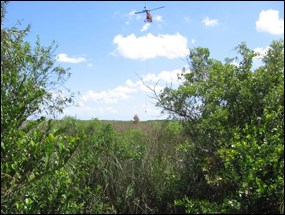
NPS photo Foliar Application A dilute mixture of herbicide and water is sprayed on the leaves and stems of the targeted plant. A surfactant is often needed to enable the herbicide to penetrate the plant cuticle. Foliar application can be from the ground using a backpack sprayer or hand-held spray bottle, or the herbicide can be aerially applied from an aircraft. Aerial spot spraying by helicopter is an effective and efficient method to treat vegetation in remote areas that are inaccessible on foot. 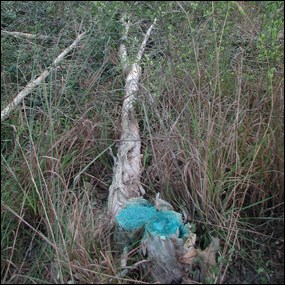
NPS photo Cut Stump Method The tree or shrub is cut down and the herbicide is immediately applied to the exposed surface. The herbicide must be applied to the entire inner bark (cambium) within minutes after the trunk is cut. Herbicide can be applied to the cut surface by backpack sprayer or hand-held spray bottle. 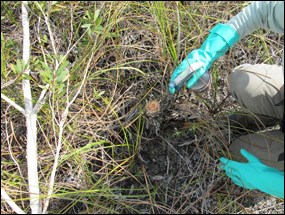
NPS photo Hack and Squirt Method The bark and cambium is cut completely around the circumference of a tree or shrub with a sharp knife, saw, ax, or machete. Multiple cuts should not be made directly above or below the original cut, because this could inhibit movement of the herbicide. Cuts should be angled down and in to hold herbicide. Herbicide is then immediately applied to the cut with a backpack sprayer or hand-held spray bottle. 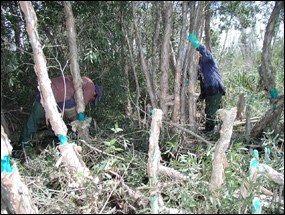
NPS photo Girdling Girdling is a type of hack and squirt used to kill standing trees. A groove is cut around the entire trunk to interrupt the flow of sap between the roots and crown of the tree. Girdling can be done with or without an herbicide; in south Florida it is usually done with herbicide to prevent the tree from re-sprouting. 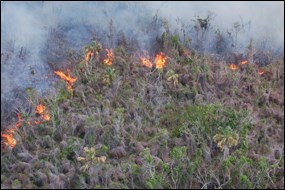
NPS photo Hazard Fuel Reduction Everglades National Park Exotic Plant Management staff works closely with fire nanagement staff in the use of prescribed fire as a tool to help manage exotic plant infestations. Exotic plants are mapped and some of the impacted areas are treated with an aerial application of herbicide. In some cases, about 6 to 18 months after herbicide treatment, the areas are burned in an attempt to decrease the biomass of exotic vegetation and slow the establishment of the exotic species. The effectiveness of fire management measures is still being evaluated. |
Last updated: September 3, 2015
